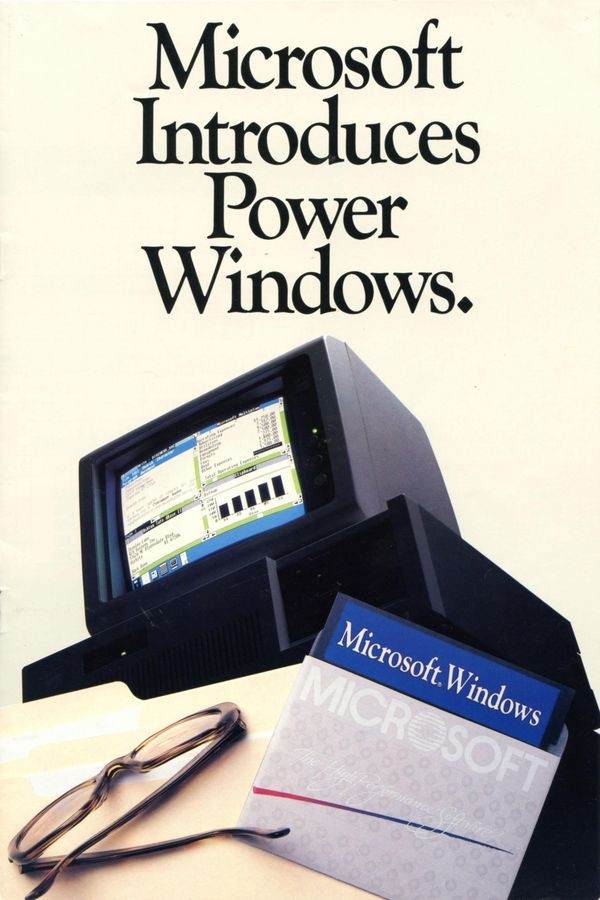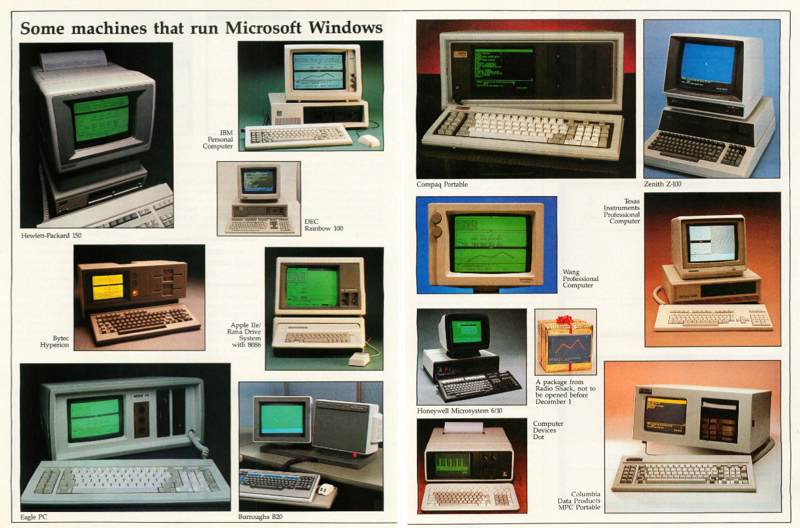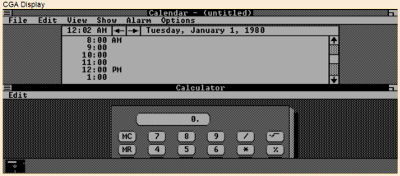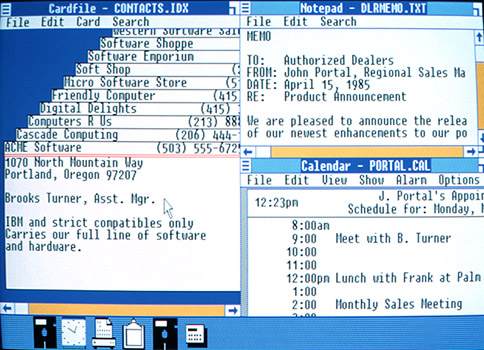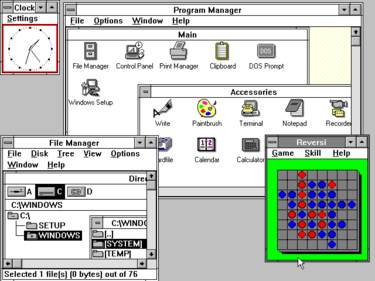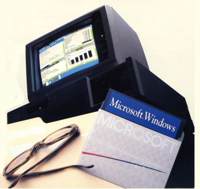| Microsoft Windows Announced 40 Years Ago |
| Written by Sue Gee | |||
| Sunday, 12 November 2023 | |||
|
Although it didn't launch until 1985, Microsoft Windows was announced in November 1983. It signaled the move for users from the command line to a GUI environment, something that some programmers still resist today. Microsoft had been working on a program to provide a graphical operating system shell for MS-DOS since 1981 in order to compete with other emerging graphical environments, in particular that of the Apple Lisa and the VisiCorp's Visi On. It was Visi On, a graphical user interface for IBM and IBM compatible PCs that had inspired Bill Gates when he saw it demoed at COMDEX in 1982.
Plans for the new operating system were revealed at a press event in New York on November 10, 1983. Its code name was "Interface Manager" but the name "Windows" replaced it because it better described the computing “windows” that were its fundamental feature Info World's coverage of the announcement reminds us that Microsoft was by no means the predominant player in the market at the time: A leading software company has opened a second front in the developing window wars. Less than two weeks after VisiCorp started shipping its long-awaited Visi On integrated software package, arch-rival Microsoft has fired an answering volley by introducing a lower-cost window manager with new features that both users and applications-program developers will love. The December 1983 issue of Byte magazine carried a 7-page preview of Windows with photos of screens that illustrated key features and a double page spread of it running on a selection of the machines that could run it: With his title, "Microsoft Windows: A mouse with modest requirements" Phil Lemmons comments on the high cost of software both for Visi On and Apple's Lisa that had limited the adoption of the mouse continuing: With the introduction of Microsoft Windows, however, the company that brought us MS-DOS promises a mouse-and-window show running off two 320K-byte floppy disks and 192K bytes of RAM. (More RAM is required, of course, with each additional application.) To make Microsoft Windows even more attractive to personal computer users, Microsoft promises to price Windows "as an operating-system component"— that is, inexpensively. Lemmon's conclusions opens with: Microsoft Windows seems to offer remarkable openness, reconfigurability, and transportability as well as modest hardware requirements and pricing. As a result, the desktop metaphor and mouse, intended to bring computing power to nontechnical people, are finally going to reach the hands of many such people. Barring a surprise product introduction from another company, Microsoft Windows will be the first large-scale test of the desktop metaphor in the hands of its intended users. and closes with: For many software authors as well as users, this will be the first chance to test an approach to the user interface that has hovered just beyond reach for several years. This is something of an understatement. Developers were about to be faced with the all the problems of coding to a graphical interface for the first time. This would have been a big step if it had only introduced the essential elements of asynchronous coding, events, the event loop and so on, but things were much more complicated due to the need to use the segmented memory management that was standard at the time. To make use of the 640KB of memory available you had to juggle with segment allocations as part of a cooperative multitasking environment. Getting anything to work under Windows was a matter of witch craft by the standards of the comparatively simple synchronous command line. Due to the time-consuming process of ironing out bug, mainly to do with memory management Windows 1.0 didn't launch until November 20th, 1985 and even then lacked some of the key features - in particular it did not allow overlapping windows. Instead, all windows were tiled.
But it was a game-changer, rather than typing MS‑DOS commands, you just moved a mouse to point and click your way through screens, or “windows.” Windows 1.0 required a minimum of 256 kilobytes (KB), two double-sided 5.25 inch floppy disk drives, and a graphics adapter card. A hard disk and 512 KB memory was recommended for running multiple programs or when using DOS 3.0 or higher. It shipped with several programs, including MS‑DOS file management, Paint, Windows Writer, Notepad, Calculator, and a calendar, card file, and clock to help you manage day-to-day activities. It even included a game, Reversi. More importantly for users it introduced features we now take for granted - drop-down menus, scroll bars, icons, and dialog boxes and the ability to switch among several programs without having to quit and restart each one. Commenting at the time, Bill Gates said: “It is unique software designed for the serious PC user.” Although Windows 1.0 achieved little popularity, Microsoft wasn't deterred and Windows' evolution continued. Windows 2.0, released in December 1987, introduced more sophisticated keyboard shortcuts and could make use of expanded memory and was followed by Windows 2.1, which came in two versions - 286 and 386 to take advantage of hardware capabilities. These early version of Windows, however, are regarded as graphical shells rather than full GUI interfaces because they ran on top of MS-DOS and used it for file ststem services. It was only with the advent of Windows 3.0 in 1990 that Windows was able to share arbitrary devices between multi-tasked DOS applications. It was also the first version of Windows to achieve broad commercial success, selling 2 million copies in the first six months.
Today Windows is a mess of different APIs and who knows what the proper way to do anything is? It has grown out of control for so many years, that it is sometimes difficult to see the original core code in the form of the Windows WinForm API. WPF, .NET, MFC, UWP, ActiveX, COM and countless DirectX-based APIs are all scattered around like the wraiths of forgotten enterprise. For more on the evolution of Windows see our new items Twenty Years Ago Window 95 Was Released, Windows 95 Turns 25 and Windows XP 10 years on If you are interested in the early years of Microsoft see the article Bill Gates - Before he was famous in our history section. For a relatively recent retrospective (2015) see Microsoft 40 Years Today.
More InformationMicrosoft Does Windows from InfoWorld 21 Nov 1983 Microsoft Windows fron Byte December 1983 Related ArticlesTwenty Years Ago Window 95 Was Released Windows 1.01, 3.0 and Mac 7 - In A Browser Bill Gates - Before he was famous
To be informed about new articles on I Programmer, sign up for our weekly newsletter, subscribe to the RSS feed and follow us on Twitter, Facebook or Linkedin.
Comments
or email your comment to: comments@i-programmer.info
|
|||
| Last Updated ( Monday, 13 November 2023 ) |
